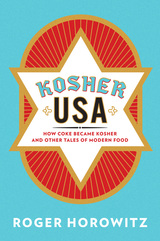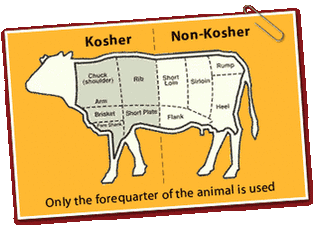
KOSHER USA:
HOW COKE BECAME KOSHER AND OTHER TALES OF MODERN FOOD Columbia University Press April 2016 A Choice Outstanding Academic Book, 2016 National Jewish Book Award, American Jewish Studies, 2016 Dorothy Rosenberg Prize for the history of the Jewish diaspora, American Historical Association, 2017 
KOSHER USA follows the journey of kosher foods through the modern industrial food system; their encroachment, conquests, limits, and exclusions. Drawing on episodes in the lives of the author’s own family, it traces how iconic products such as Coca Cola and Jell-O tried to become kosher; what made Manischewitz
wine the very first kosher name-brand product to gain a wide non-Jewish audience -- and one that was principally African American; the techniques used by Orthodox rabbinical organizations to embed kosher requirements in the very production systems for modern food; and the grave difficulties encountered by kosher meat and other kosher foods that fell outside of the culinary consensus of America’s predominantly non-Jewish consumers. Rich with stories about the key figures in this process, Kosher USA relates a tale redolent of great accomplishments and stubborn limitations that is reflective of the experiences of Jews in the predominantly Christian USA. AN EXCERPT FROM THE PROLOGUE:
Uncle Stuart, my mother’s oldest brother, religiously attended the holiday parties at her Manhattan apartment with his wife Doris –on Christmas day (brisket, not ham, was on the table) and for the Passover Seder. As they aged, it became harder and harder for them to participate, but because of Stu’s stubborn perseverance, they came nonetheless. Aunt Doris went through a long struggle with Parkinson’s disease that progressively deprived her of control over her body – and eventually the ability to speak. Stu went to great lengths to bring her, even after he contracted incurable bone cancer, and could no longer lift Doris into a taxi as he once had. The last time I saw Stu, at the 2005 Christmas day party to which my mother invited friends, business associates, and family, the visit was especially difficult. Without the aide who was spending the day with her family, Stu had pushed Doris’ wheel chair a mile in a bone-chilling December rain (draping it with clothes and large garbage bags to protect her) from his Upper West Side apartment to my mother’s place on 72nd street. When they arrived, Stu was only good cheer – not a word of complaint. We pulled out my mother’s Slivovitz and drank several shots; he asked after my son and talked about the Spanish lessons he was taking. I told stories and didn’t ask after his health or Doris, knowing the answers already and not wanting to dent his upbeat mood. It got late, and Stu’s younger brother Ernest offered to drive him and Doris home; Stu tried to demur but we insisted, the rain had not stopped. As Doris could not stand and Stu no longer could lift her, I was enlisted to help. So we went downstairs and I carried Doris from her wheelchair into Ernie’s SUV, and then helped Stuart get in before returning upstairs to collect the raingear he had used earlier. On an impulse, I grabbed the one advance copy I had received of my new book, Putting Meat on the American Table, and gave it to Stu in the car. I rode back to his apartment so I could help move Doris inside; we had a chance to talk about the book for a short time before I walked back to my mother’s place. I think we both sensed that this might be the last time we would meet. A day or two later he called my mother about the book; she rang a few days later to relate the conversation. He had read it, said he liked it, but wanted to know why I didn’t write about kosher meat? After all, it was part of our heritage and should have been part of the story that I was seeking to tell – and he would like to talk with me about it. We never had that conversation -- Stu died a few days later. But his question stayed in my mind, even if the chance to talk with him was gone. It was a profound question (befitting a man whom my father once called “the smartest man he ever knew”) that stirred my mental energies – Stu was asking, in essence, was it possible to write about the modern food system and ignore kosher food? Did kosher food fit into the industrial methods that now delivered so much food to our society? Or was it in some way marginal, excluded, unimportant in modern secular society? What did that answer say about the place of Jewish traditions in American culture? His question also pointed to how I might bring something unusual to an answer – personal experience growing up in a kosher household, and the scholarship to conduct necessary research. Much as this Christmas evening left a riveting impression on me it was Stu’s intellect and insight that put me on to this project for almost a decade – not sentimental obligation; and I think that was what Stu would have wanted. |
|
